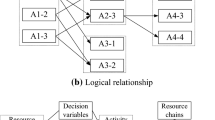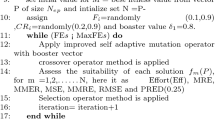Abstract
The Multimode Resource-Constrained (MRC) problem aims at finding the start times and execution modes for the activities of a project that minimizes project duration under current precedence constraints and resource limitations. This study integrates the fuzzy c-means clustering technique and the chaotic technique into the Differential Evolution to develop the Fuzzy Clustering Chaotic-based Differential Evolution (FCDE) algorithm, an efficient hybrid approach to solving MRC and other related problems. Within the FCDE, the chaos prevents the optimization algorithm from premature convergence and the fuzzy c-means clustering acts as several multi-parent crossover operators for utilizing population information efficiently and enhance convergence efficiency. Further, this study applies a serial method to reflect individual-user priorities into the active schedule and the project duration calculations. Experiments run indicate that the proposed FCDE-MRC obtains optimal results more reliably and efficiently than the benchmark algorithms considered. The FCDE-MRC is a promising alternative methodology to handling resource-constrained problems.
Similar content being viewed by others
References
Alcaraz, J. and Maroto, C. (2001). “A robust genetic algorithm for resource allocation in project scheduling.” Annals of Operations Research, Vol. 102, Nos. 1–4, pp. 83–109, DOI: 10.1023/A:1010949931021.
Alcaraz, J., Maroto, C., and Ruiz, R. (2003). “Solving the multi-mode resource-constrained project scheduling problem with genetic algorithms.” Journal of the Operational Research Society, Vol. 54, No. 6, pp. 614–626, DOI: 10.1057/palgrave.jors.2601563.
Ozer, A. B. (2010). “CIDE: Chaotically initialized differential evolution.” Expert Systems with Applications, Vol. 37, No. 6, pp. 4632–4641, DOI: 10.1016/j.eswa.2009.12.045.
Cai, Z., Gong, W., Ling, C. X., and Zhang, H. (2011). “A clusteringbased differential evolution for global optimization.” Applied Soft Computing, Vol. 11, No. 1, pp. 1363–1379, DOI: 10.1016/j.asoc.2010.04.008.
Cheng, M. Y., and Tran, D. H. (2014). “Two-phase differential evolution for the multiobjective optimization of time–cost tradeoffs in Resourceconstrained construction projects.” Engineering Management, IEEE Transactions on, Vol. 61, No. 3, pp. 450–461, DOI: 10.1109/TEM.2014.2327512.
Cheng, M.-Y., Huang, K.-Y., and Chen, H.-M. (2012). “Dynamic guiding particle swarm optimization with embedded chaotic search for solving multidimensional problems.” Optimization Letters, Vol. 6, No. 4, pp. 719–729, DOI: 10.1007/s11590-011-0297-z.
Damak, N., Jarboui, B., Siarry, P., and Loukil, T. (2009). “Differential evolution for solving multi-mode resource-constrained project scheduling problems.” Computers & Operations Research, Vol. 36, No. 9, pp. 2653–2659, DOI: 10.1016/j.cor.2008.11.010.
Deb, K. (2005). “A population-based algorithm-generator for real-parameter optimization.” Soft Comput, Vol. 9, No. 4, pp. 236–253, DOI: 10.1007/s00500-004-0377-4.
Elbeltagi, E., Hegazy, T., and Grierson, D. (2005). “Comparison among five evolutionary-based optimization algorithms.” Advanced Engineering Informatics, Vol. 19, No. 1, pp. 43–53, DOI: 10.1016/j.aei.2005.01.004.
Elloumi, S. and Fortemps, P. (2010). “A hybrid rank-based evolutionary algorithm applied to multi-mode resource-constrained project scheduling problem.” European Journal of Operational Research, Vol. 205, No. 1, pp. 31–41, DOI: 10.1016/j.ejor.2009.12.014.
Jarboui, B., Damak, N., Siarry, P., and Rebai, A. (2008). “A combinatorial particle swarm optimization for solving multi-mode resourceconstrained project scheduling problems.” Applied Mathematics and Computation, Vol. 195, No. 1, pp. 299–308, DOI: 10.1016/j.amc.2007.04.096.
Jia, D., Zheng, G., and Khurram Khan, M. (2011). “An effective memetic differential evolution algorithm based on chaotic local search.” Information Sciences, Vol. 181, No. 15, pp. 3175–3187, DOI: 10.1016/j.ins.2011.03.018.
Jiang, B. L. W. (1998). “Optimizing complex functions by chaos search.” Cybernetics and Systems, Vol. 29, No. 4, pp. 409–419, DOI: 10.1080/019697298125678.
Kim, J. H. and Stringer, J. (1992). Applied chaos, Electric Power Research Institute, Palo Alto, California.
Kolisch, R. (1996). “Serial and parallel resource-constrained project scheduling methods revisited: Theory and computation.” European Journal of Operational Research, Vol. 90, No. 2, pp. 320–333, DOI: 10.1016/0377-2217(95)00357-6.
Kwedlo, W. (2011). “A clustering method combining differential evolution with the K-means algorithm.” Pattern Recognition Letters, Vol. 32, No. 12, pp. 1613–1621, DOI: 10.1016/j.patrec.2011.05.010.
Li, H. and Zhang, H. (2013). “Ant colony optimization-based multimode scheduling under renewable and nonrenewable resource constraints.” Automation in Construction, Vol. 35, pp. 431–438, DOI: 10.1016/j.autcon.2013.05.030.
Liao, T., Warren, P. J., Egbelu, B. R., Sarker, and Leu, S. S. (2011). “Metaheuristics for project and construction management — A state-of-the-art review.” Automation in Construction, Vo. 20, No. 5, pp. 491–505, DOI: 10.1016/j.autcon.2010.12.006.
Lova, A., Tormos, P., Cervantes, M., and Barber, F. (2009). “An efficient hybrid genetic algorithm for scheduling projects with resource constraints and multiple execution modes.” International Journal of Production Economics, Vol. 117, No. 2, pp. 302–316, DOI: 10.1016/j.ijpe.2008.11.002.
Lu, M., Lam, H.-C., and Dai, F. (2008). “Resource-constrained critical path analysis based on discrete event simulation and particle swarm optimization.” Automation in Construction, Vol. 17, No. 6, pp. 670–681, DOI: 10.1016/j.autcon.2007.11.004.
Noman, N. and Iba, H. (2008). “Accelerating differential evolution using an adaptive local search.” Evolutionary Computation, IEEE Transactions on, Vol. 12, No. 1, pp. 107–125, DOI: 10.1109/TEVC.2007.895272.
Ohya, M. (1998). “Complexities and their applications to characterization of chaos.” International Journal of Theoretical Physics, Vol. 37, No. 1, pp. 495–505, DOI: 10.1023/A:1026620313483.
Peteghem, V. V. and Vanhoucke, M. (2010). “A genetic algorithm for the preemptive and non-preemptive multi-mode resource-constrained project scheduling problem.” European Journal of Operational Research, Vol. 201, No. 2, pp. 409–418, DOI: 10.1016/j.ejor.2009.03.034.
Price, K. V., Storn, R. M., and Lampinen, J. A. (2005). Differential evolution a practical approach to global optimization, Springer-Verlag Berlin Heidelberg 2005.
Rostami, M., Moradinezhad, D., and Soufipour, A. (2014). “Improved and competitive algorithms for large scale multiple resource-constrained project-scheduling problems.” KSCE Journal of Civil Engineering, Vol. 18, No. 5, pp. 1261–1269, DOI: 10.1007/s12205-014-0401-x.
Sakalauskas, L. and Felinskas, G. (2006). “Optimization of resource constrained project schedules by genetic algorithm based on the job priority list.” Information Technology and Control, Vol. 35, No. 4, 412–418, DOI: 10.1.1.103.7996.
Storn, R. M. and Price, K. (1997). “Differential evolution — A simple and efficient heuristic for global optimization over continuous spaces.” Journal of Global Optimization, Vol. 11, pp. 341–359, DOI: 10.1023/A:1008202821328.
Wang, Y.-J., Zhang, J.-S., and Zhang, G.-Y. (2007). “A dynamic clustering based differential evolution algorithm for global optimization.” European Journal of Operational Research, Vol. 183, No. 1, pp. 56–73, DOI: 10.1016/j.ejor.2006.10.053.
Wu, L., Wang, Y., and Zhou, S. (2010). “Improved differential evolution algorithm for resource-constrained project scheduling problem.” Systems Engineering and Electronics, Journal of, Vol. 21, No. 5, pp. 798–805, DOI: 10.3969/j.issn.1004-4132.2010.05.013.
Zhang, H. (2012). “Ant colony optimization for multimode resourceconstrained project scheduling.” Journal of Management in Engineering, Vol. 28, No. 2, pp. 150–159, DOI: 10.1061/(ASCE)ME.1943-5479.0000089.
Zhang, H., Tam, C. M., and Shi, J. J. (2002). “Simulation-based methodology for project scheduling.” Construction Management and Economics, Vol. 20, No. 8, pp. 667–678, DOI: 10.1080/0144619022000014088.
Zhang, H., Li, H., and Tam, C. (2006a). “Particle swarm optimization for resource-constrained project scheduling.” International Journal of Project Management, Vol. 24, No. 1, pp. 83–92, DOI: 10.1016/j.ijproman.2005.06.006.
Zhang, H., Li, H., and Tam, C. (2006b). “Permutation-based particle swarm optimization for resource-constrained project scheduling.” Journal of Computing in Civil Engineering, Vol. 20, No. 2, pp. 141–49, DOI: 10.1061/(ASCE)0887-3801(2006)20:2(141).
Zhang, H., Tam, C. M., and Li, H. (2006c). “Multimode project scheduling based on particle swarm optimization.” Computer-Aided Civil and Infrastructure Engineering, Vol. 21, No. 2, 93–103, DOI: 10.1111/j.1467-8667.2005.00420.x.
Zhang, Z. and Xu, J. (2014). “Applying rough random MODM model to resource-constrained project scheduling problem: A case study of Pubugou Hydropower Project in China.” KSCE Journal of Civil Engineering, Vol. 18, No. 5, pp. 1279–1291, DOI: 10.1007/s12205-014-0426-1.
Zielinski, K., Weitkemper, P., Laur, R., and Kammeyer, K. D. (2006). “Parameter study for differential evolution using a power allocation problem including interference cancellation.” In Evolutionary Computation, 2006, CEC 2006, IEEE Congress on., pp. 1857–1864, DOI: 10.1109/cec.2006.1688533.
Author information
Authors and Affiliations
Corresponding author
Rights and permissions
About this article
Cite this article
Cheng, MY., Tran, DH. An efficient hybrid differential evolution based serial method for multimode resource-constrained project scheduling. KSCE J Civ Eng 20, 90–100 (2016). https://doi.org/10.1007/s12205-015-0414-0
Received:
Revised:
Accepted:
Published:
Issue Date:
DOI: https://doi.org/10.1007/s12205-015-0414-0




